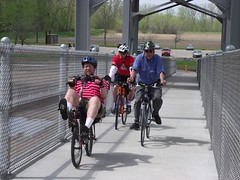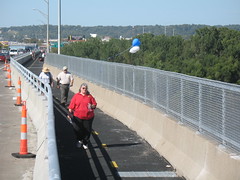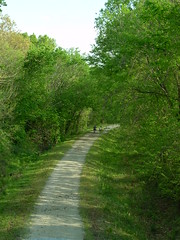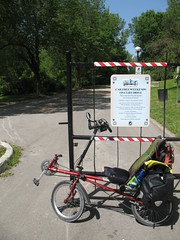Transportation Enhancements under attack: What is it and why is it important?
Today the national bicycle and pedestrian groups sent an advocacy alert asking us to contact our senators--federal Transportation Enhancements funding, the main source of funding for bicycle and pedestrian projects in the United States, is under attack again by a small group of senators.
Unfortunately, among the opponents of Transportation Enhancements is Missouri's own Senator Claire McCaskill.

Every time this issue comes up, I receive calls and emails asking why Transportation Enhancements is important, why should we support it, and with the federal government running out of money and all, isn't it one of those frilly and unimportant programs we should be cutting?
Below are some of the answers to those questions.
What does Transportation Enhancements fund?
What kind of bicycle and pedestrian projects does Transportation Enhancements fund? It's everything from bike lanes to shoulders to sidewalks to crosswalks to trails to bridge and viaduct expansion or retrofit for bicycle/pedestrian access, and much more. Basically any bicycle or pedestrian project you see around your neighborhood, your city, or the state is could be funded by Transportation Enhancements.
Our page about Transportation Enhancements in Missouri lists projects by congressional district.
Key facts:
- Since 1991, the Transportation Enhancements program has leveraged $45 million in local funds with more than $100 million in federal funds.
- T.E. funds have been broadly distributed around Missouri.
- Grants are competitive and merit-based, they are not earmarks.
- Grants always require considerable local participation in project design, planning, and funding. Federal funds only pay part of the cost--just as they do for similar road projects.
Why is Transportation Enhancements important?
Bicycling and walking in the U.S. hit a low point in the 1990s. That low point was the result of years of neglect of bicycle and pedestrian infrastructure.
Two things we know from years of research into bicycling and walking:
- The more (and better) bicycle and pedestrian facilities an area has, the more people in that area bicycle and walk
- The more people in an area bicycle and walk, the safer bicycling and walking in that area becomes
The primary reason for the neglect of bicycle and pedestrian infrastructure from the mid 1900s through the 1990s was that the federal government had become a primary source of funding for roads and highways across the country. And not just interstate freeways--all federal and state highways are eligible for federal funding, but so are primary roads and streets in every city across the country.

This all changes in 1991, when some visionary leaders realized that we need to create a transportation system for Americans, not American automobiles. Advance planning, required of all states and regional planning organizations, was required to take bicycling and walking into account, and federal transportation funding included small amounts designated for bicycling, walking, and other similar priorities.
The Transportation Enhancements program, which today totals about 2% of the annual federal transportation budget, was one of the primary changes of this new approach.

Since Transportation Enhancements was started in 1991, we have seen a sea change in the environment for bicycling and walking in the U.S. After decades of neglect, it has taken two decades to start to reverse that progress. But the progress and improvement we have seen in Missouri in bicycling and walking over the past few years is in very large part a result of Transportation Enhancements funding.
If we want to see that progress continue and accelerate, we must continue Transportation Enhancements.
If we want to see that progress reverse and decline, all we need to do is stop Transportation Enhancements funding.
It is a very small percentage of the federal budget that makes a huge difference in our neighborhoods and communities.
Why bicycle and pedestrian funding makes the most sense in a time of tight budgets
If anything, we need to increase, not decrease the proportion of funding for bicycling and walking in these times of tight budgets.
Why?
- With unemployment high and the price of gas soaring, more Americans are relying on bicycling and walking for basic transportation.
- With the national rate of obesity high and headed even higher, changing our built environment to become more welcoming for bicycling and walking is one of the few ways proven to change community health and fitness patterns. Obesity current costs Missourians about $2 billion per year in direct medical costs, and by 2018 that amount promises to be over $8 billion annually--unless we do something. Reasonable investment in bicycling and walking facilities more than pays for itself, just in health benefits alone.
- Bicycle and pedestrian projects are more labor intensive and less materials intensive than road and highway projects. The result: More jobs per dollar spent.
- Compared with road and highway projects, bicycle and pedestrian projects have the potential to create more access for more people to reach more destinations at a fraction of the cost of highway and road projects.
Let me give just one example of the cost savings involved.
Recently MoDOT rebuilt the I-29/I-35 Missouri River bridge and connections in Kansas City. The project cost $245 million. It will move about 100,000 vehicles per day about two miles.
That is a lot of people--but also a lot of money. A quarter billion dollars just for two miles of the region's freeway system, which is a few hundred miles total, and costs many millions per mile even for the simplest and least expensive part of the system.
By contrast, I was recently involved in creating an estimate for creating a citywide bicycle system. The system would have totalled a few hundred miles, reached every part of the city, and carried something like 50,000 trips per day.
Total cost: $19 million.
This is true of projects across Missouri and the U.S.: For the price of one single interstate freeway interchange in one place, we could create a bicycle, pedestrian, and trails system covering an entire small city. For the price of one mile of interstate freeway, we could build dozens of miles of trails or sidewalks, and hundreds of miles of bicycle lanes and routes.
Our position: Bicycle and pedestrian transportation must receive its fair share
Some people argue that the federal government should not fund bicycle and pedestrian projects.
Perhaps the federal a government should not fund any local transportation projects, or any transportation projects at all. That is a political debate and discussion that will have to be played out across the country.

But our position is this: As long as the federal government is funding transportation projects, the federal government must also fund a fair share of bicycle and pedestrian projects.
We don't have to wonder what happens if the federal government does not do this. That experiment has been tried, from the mid 1900s through 1991, and the result was a miserable failure.
No federal transportation funding for bicycling and walking meant that bicycling and walking infrastructure--trails, sidewalks, crosswalks, bicycle lanes, and all the rest--was almost completely neglected. And the rates of bicycling and walking, and the overall health of the U.S. citizenry, plummeted.
Since the beginning of the Transportation Enhancements program in 1991, those dismal statistics, and the attitudes of transportation planners, engineers, and decision-makers, has slowly but surely been turning around.
Counterpoint: Should the proportion spent on bicycling and walking be even higher?
In fact, in the U.S. today, bicycling and walking represents about 10% of all trips. In Missouri, bicycling and walking represents somewhere between 5% and 10% of all trips.
Bicyclist and pedestrians represent between 8% and 10% of roadway fatalities in Missouri, and over 14% of roadway injuries.
The federal Transportation Enhancements program sets aside about 2% of federal transportation funds.
In fairness, we should be spending in proportion to mode share and injury rates--that would mean a dramatic increase in the proportion of funds spent on bicycle and pedestrian projects, far beyond 2%.
That may sound revolutionary.
But in a democratic country, why are we not supporting the modes of transportation that people are freely choosing to use?
And why are we not supporting them in proportion to the amount that people are using them?

In fact we know, because study after study has shown, that people are willing and anxious to walk and bicycle more than they do. What is holding them back is the lack of close, convenient, safe places to bicycle and walk. If our country, as a matter of national priority, spent a reasonable amount on bicycle and pedestrian facilities, the percentage of bicycling and walking trips would skyrocket.
And bicycle and pedestrian projects are so inexpensive in comparison to other transportation projects, that our country could afford to increase the amount spent on bicycle and pedestrian needs while reducing the overall outlays for transportation.
It is not a matter of how much is (or should be) in the budget, as what our national needs and priorities are--and should be--in comparison with other funding priorities that will be in the budget.
Contact your elected officials--it really does make a difference
With Transportation Enhancements under attack--again--it really does pay off to contact your elected officials. Millions of us bicycle and walk regularly, we appreciate improved safety, improved access, and better roads, streets, and trails for bicycling and walking.
When your elected officials hear you tell your stories, it really does make a difference.
It only takes two minutes
Click here to contact your senators in support of bicycle and pedestrian funding
- Advocacy Alerts
- News
- 2011
- about
- adt
- advocacy
- Advocacy Alert
- advocacy101
- america
- automobiles
- bicycle
- bicycle lanes
- bicycling
- bicyclist
- bicyclists
- Bike
- bike lanes
- blue springs
- bridge
- budget
- city
- community
- cost
- environment
- fatalities
- federal funding
- federal transportation
- fitness
- form
- funding
- grant
- grants
- health
- health benefit
- health benefits
- heart of america
- illinois
- infrastructure
- injuries
- injury
- interstate freeway
- issues
- jefferson city
- kansas
- kansas city
- kansascity
- katy trail
- links
- mccaskill
- missouri
- missouri bicycle federation
- missouri river
- missouri river bridge
- Missouri Tourism
- mobikefed
- modot
- much more
- neighborhood
- neighborhoods
- obesity
- path
- pedestrian
- pedestrians
- planning
- research
- roads
- routes
- running
- safety
- savings
- shoulders
- sidewalks
- statistics
- story
- streets
- study
- trail
- trails
- transportation
- transportation enhancements
- transportation funding
- vacation
- walking
- Bicycle
- Business
- Chicagoland Bicycle Federation
- Claire McCaskill
- Cycling
- Exercise
- Freeway
- Human behavior
- Kansas City
- Locomotion
- Missouri
- Missouri River Bridge
- Pedestrian
- Recreation
- Road transport
- Segregated cycle facilities
- Sustainability
- Sustainable transport
- Trail
- Transport
- transportation
- Transportation planning
- Walking
Join MoBikeFed's Advocacy Network
Working together we make a real difference! Join our advocacy network:
Related pages
Current topics...
Archives...
Want better bicycling and walking in Missouri?
We rely on the support of members like you. Please join, renew, or donate today.
- Home
- JOIN/DONATE
- News/Info
- Missouri Bicycling, Running, Trails
- Bicycle Skills and Safety
- Missouri Bike/Ped Law
- Clubs and Organizations
- Bike Shops
- Running Shops
- Bicycling, Running, Trails-related Businesses
- Ride, Run, Walk, Hike, Triathlon, and Events Calendars
- Bicycles on Amtrak
- Maps and Routes
- Trails and Trail Maps
- IBikeMO.org
- Planning a Missouri bicycle trip
- Gravel and Bikepacking Maps & Routes
- Bicycle & Touring Routes
- Advocacy
- Campaigns
- Our Legislative Platform
- Complete Streets
- Statewide Rock Island Trail
- Statewide Trail Vision - Quad State Trail
- Bicycle Friendly Missouri
- Walk Friendly Missouri
- Safe Routes to School
- MoDOT funding crisis
- High Priority Bike/Ped Project List
- Anti-harassment laws in cities & statewide
- Updating the basic bicycle law
- Our Vision for MoDOT
- Our Vision for MPOs/RPCs
- Our Vision for Cities & Counties
- Bicycle, pedestrian, trails plans across MO
- Protecting Vulnerable Road Users
- Vision Zero
- Missouri Trail Towns
- Store
- About

